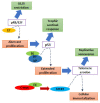Epidemiology, Molecular Pathogenesis, Immuno-Pathogenesis, Immune Escape Mechanisms and Vaccine Evaluation for HPV-Associated Carcinogenesis
- PMID: 38133265
- PMCID: PMC10745624
- DOI: 10.3390/pathogens12121380
Epidemiology, Molecular Pathogenesis, Immuno-Pathogenesis, Immune Escape Mechanisms and Vaccine Evaluation for HPV-Associated Carcinogenesis
Abstract
Human papillomavirus (HPV) is implicated in over 90% of cervical cancer cases, with factors like regional variability, HPV genotype, the population studied, HPV vaccination status, and anatomical sample collection location influencing the prevalence and pathology of HPV-induced cancer. HPV-16 and -18 are mainly responsible for the progression of several cancers, including cervix, anus, vagina, penis, vulva, and oropharynx. The oncogenic ability of HPV is not only sufficient for the progression of malignancy, but also for other tumor-generating steps required for the production of invasive cancer, such as coinfection with other viruses, lifestyle factors such as high parity, smoking, tobacco chewing, use of contraceptives for a long time, and immune responses such as stimulation of chronic stromal inflammation and immune deviation in the tumor microenvironment. Viral evasion from immunosurveillance also supports viral persistence, and virus-like particle-based prophylactic vaccines have been licensed, which are effective against high-risk HPV types. In addition, vaccination awareness programs and preventive strategies could help reduce the rate and incidence of HPV infection. In this review, we emphasize HPV infection and its role in cancer progression, molecular and immunopathogenesis, host immune response, immune evasion by HPV, vaccination, and preventive schemes battling HPV infection and HPV-related cancers.
Keywords: HPV-associated carcinogenesis; HPV-infection; immune evasion; immuno-pathogenesis; vaccination.
Conflict of interest statement
The authors have no conflicts of interest.
Figures




Similar articles
-
Recent Developments in Human Papillomavirus (HPV) Vaccinology.Viruses. 2023 Jun 26;15(7):1440. doi: 10.3390/v15071440. Viruses. 2023. PMID: 37515128 Free PMC article. Review.
-
Immunopathogenesis of HPV-Associated Cancers and Prospects for Immunotherapy.Viruses. 2017 Sep 12;9(9):254. doi: 10.3390/v9090254. Viruses. 2017. PMID: 28895886 Free PMC article. Review.
-
Long-term incidence trends of HPV-related cancers, and cases preventable by HPV vaccination: a registry-based study in Norway.BMJ Open. 2018 Feb 23;8(2):e019005. doi: 10.1136/bmjopen-2017-019005. BMJ Open. 2018. PMID: 29476028 Free PMC article.
-
Immunogenicity of next-generation HPV vaccines in non-human primates: Measles-vectored HPV vaccine versus Pichia pastoris recombinant protein vaccine.Vaccine. 2016 Sep 7;34(39):4724-4731. doi: 10.1016/j.vaccine.2016.07.051. Epub 2016 Aug 11. Vaccine. 2016. PMID: 27523740 Free PMC article.
-
Vaccination Strategies for the Control and Treatment of HPV Infection and HPV-Associated Cancer.Recent Results Cancer Res. 2021;217:157-195. doi: 10.1007/978-3-030-57362-1_8. Recent Results Cancer Res. 2021. PMID: 33200366 Free PMC article.
Cited by
-
An exploration of the natural and acquired immunological mechanisms to high-risk human papillomavirus infection and unmasking immune escape in cervical cancer: A concise synopsis.Tzu Chi Med J. 2024 Dec 3;37(1):28-41. doi: 10.4103/tcmj.tcmj_134_24. eCollection 2025 Jan-Mar. Tzu Chi Med J. 2024. PMID: 39850385 Free PMC article. Review.
-
Comprehensive Analysis of Papillomavirus (PV) and Its Implications in Cancer: Bridging the Gap between Human and Veterinary Medicine.Arch Razi Inst. 2024 Dec 31;79(6):1145-1154. doi: 10.32592/ARI.2024.79.6.1145. eCollection 2024 Dec. Arch Razi Inst. 2024. PMID: 40599446 Free PMC article. Review.
-
Human papillomavirus and male infertility correlation analysis following World Health Organization 2021 guidelines.Sci Rep. 2024 Nov 9;14(1):27422. doi: 10.1038/s41598-024-79047-1. Sci Rep. 2024. PMID: 39521918 Free PMC article.
-
Cervical cancer trends, HPV vaccine utilization, and screening in low- and lower-middle-income countries: an updated review.Ther Adv Vaccines Immunother. 2025 Jul 24;13:25151355251356646. doi: 10.1177/25151355251356646. eCollection 2025. Ther Adv Vaccines Immunother. 2025. PMID: 40718465 Free PMC article. Review.
-
Targeted and untargeted metabolomics uncovering the effects of Jiawei Ermiao Granule on patients with persistent HPV infection.Front Cell Infect Microbiol. 2025 Apr 7;15:1550908. doi: 10.3389/fcimb.2025.1550908. eCollection 2025. Front Cell Infect Microbiol. 2025. PMID: 40260114 Free PMC article.
References
-
- Rodríguez-Álvarez M.I., Gómez-Urquiza J.L., Husein-El Ahmed H., Albendín-García L., Gómez-Salgado J., Cañadas-De la Fuente G.A. Prevalence and risk factors of human papillomavirus in male patients: A systematic review and meta-analysis. Int. J. Environ. Res. Public Health. 2018;15:2210. doi: 10.3390/ijerph15102210. - DOI - PMC - PubMed
-
- Smith J.S., Herrero R., Bosetti C., Munoz N., Bosch F.X., Eluf-Neto J., Castellsagué X., Meijer C.J., Van den Brule A.J., Franceschi S. Herpes simplex virus-2 as a human papillomavirus cofactor in the etiology of invasive cervical cancer. J. Natl. Cancer Inst. 2002;94:1604–1613. doi: 10.1093/jnci/94.21.1604. - DOI - PubMed
Publication types
LinkOut - more resources
Full Text Sources

